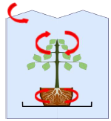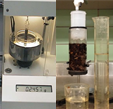- Index
- >Innovation
- >The innovation box
- >11. Soilless cultivation and/or under shelter
- >Research resultats
Contents
- Improve your horticultural growing media
- Reduce the irrigation of your horticultural growing media
- Manage your nitrogen fertilisation in soil-less conditions
- Microorganisms, a fertility factor in soil-less cultivation
- Optimize the climate around yours plants
- Optimize the energie efficiency of your greenhouses
- Conciliate energy saving and yield optimisation
- Contril your climatic parameters to manage pathogens
Aboveground and / or under-shelter production systems are growing rapidly, and must meet major challenges, both in terms of perfomance and in thems of reducing inputs and protecting natural resources.
Nitrogen fertilization, reduction in the use of peat root development, management of irrigation and the climatic environment of plant, energy saving ... are therefore all research topics of interest to professionals (market garners, producers of ornamental plants, greenhouse and substate producers).
 Angers is recognized for its academic skills in the field of (bio-) physical transfers in the plant environment in highly anthropised or artificialized constrained environment. The
EPHor
research unit is working to better understand and understand off-ground and/or under-ground production systems. Researchers are studying the interactions between organic culture media and roots as well as the consequences on the bioavailability of water, air and nutrients during culture.They are also interested in the transfer of water and energy in the substrate-plant-atmosphere continuum under irrigation restriction conditions. Their work sometimes uses the skills of the Arch-E team of
IRHS the research unit, that is specialist in plant eco-physiology.
Angers is recognized for its academic skills in the field of (bio-) physical transfers in the plant environment in highly anthropised or artificialized constrained environment. The
EPHor
research unit is working to better understand and understand off-ground and/or under-ground production systems. Researchers are studying the interactions between organic culture media and roots as well as the consequences on the bioavailability of water, air and nutrients during culture.They are also interested in the transfer of water and energy in the substrate-plant-atmosphere continuum under irrigation restriction conditions. Their work sometimes uses the skills of the Arch-E team of
IRHS the research unit, that is specialist in plant eco-physiology.
These skills enable researchers to propose ways to meet the societal demand for the performance of these production systems while reducing the environmental impact:
- Improve the phyical properties of substrates
- Favor organic fertilization
- Better control greenhouse climate by modeling
- Better manage water resources
- Valorise alternative materials
Improve your horticultural growing media
Reduce the irrigation of your horticultural growing media

experimentation substrates
Text'EAU Terreau project (2019-2023) – funds from Région Pays de la Loire and professional consortium.
This project is led by
EPHor
research unit in partnership with several culture media manufactures, to evaluate the size and shape of the media particules (texture), analyze their arrangement (structure) and predict their physical and hydraulic behaviour.
- Expected Results:
- The quantitative and qualitative analysis of the size and shape of the particules will enable to elaborate a close classification of the culture media texture.
- The study of the relationships texture vs structure, physical properties and rehumectation abilities, will enable to build a predictive model of the physical behaviour of the culture media according to their textural caracteristics, and thus to propose new mixes.

Ecol'EAU Terreau project
Ecol'EAU Terreau project (2013-2017) – funds from Angers Loire Métropole and professional consortium.
This project was performed by
EPHor
research unit in partnership with 11 culture media manufactures, to evaluate the effect of root development and irrigation regime on transfer properties and on bioavailability in water and air in organic substrates.
- Results: This project has demonstrated the aerating properties of the substrate and its wettability as key physical parameters favoring root development. In extenso, this project contributes to optimise
- the association of substrates on the basis of these new criteria,
- the management of irrigation.

OPTIFRAISE project
OPTIFRAISE project (2015-2018) - funds from FEDER , Région Nelle Aquitaine, Fraises de France and private companies.
The project is driven by Ivennio with a consortium of partners (Chambre d'agriculture 47, ValPrim , INRA Bordeaux, EPHor research unit and private conpanies). It aims to optimise irrigation management in soilless straberries cultivation.
- Results: This project highlights the effectiveness of irrigation management using tensiometers and water content probes, allowing significant reduction in water intake (around 20%) compared to the usual practices of producers.

REWET project
REWET project (2018-2019) - private funds
This project is performed by EPHor research unit, in partnership with private companies.
- Objective: Optimise the composition of the substrate by analysing the influence of the incorporation of coconut fibers and wetting agents on the ability to re-wet peat substrates according to irrigation techniques.
![]()
Jean Charles Michel
Jean Charles Michel
jean-charles.michel @ agrocampus-ouest.fr
Manage your nitrogen fertilisation in soil-less conditions

OPTiFaz Project
OPTiFaz Project (2017-2020) - funds from CASDAR
Driven by ASTREDHOR , this project aims to optimize organic nitrogen fertization in horticultural growing media, by developing a predictive tool based on the modeling of organic nitrogen mineralization under ground conditions.
- Objective: field management tools to support the management of organic fertilization and determine nitrogen requirements in the crop cycle.
René Guenon

René Guenon
rene.guenon@agrocampus-ouest.fr (patrice.cannavo @ agrocampus-ouest.fr)
Microorganisms, a fertility factor in soil-less cultivation

Microorganisms, fertility
Louise Paillat has been recruited by Premier Tech for a Cifre thesis (2018-2021), and is co-supervised by EPHor and IRHS (Arch-E team) research unit. She studies the role of the rhizosphere microorganisms in complex "organic fertilizer-substrate" medium on the nutrients bioavailability and on plant growth.
- Objective: improve the fertility of substrates by controlling microorganisms of the rhizosphere
![]()
Patrice Cannavo
Patrice Cannavo
Optimize the climate around yours plants
Optimize the energy efficiency of your greenhouses

Hortinergy
Hortinergy project (2017-2018) - ADEME funds
EPHor , Agrithermic, CTIFL (Balandran and Carquefou) and ASTREDHOR (RATHO).

GreenTech
- Results: A simulation sofware for the energy balance and GHG emissions of greehouse has been developed by integrating the contribution of plants.
Conciliate energy savings and yield optimisation

Conser project
Conser project (2014-2017) - funds from Région Pays de la Loire / FranceAgriMer / ARELPAl
CTIFL (Carquefou), CDDM , EPHor , HortiMaXFrance, Cheminant
The aim is to test and validate innovative crop management methods for greenhouse-grown cucumber, that have been determined according to the plant physiology. For this, the project conciliates energy savings and optimization of yield while reducing the impact of Didymella Bryoniae (a pathogenic fungus).
- Results: Recommendations on how to optimally control the climate in production greenhouses, improve the efficiency of cucumber crops (for example: partial relocation of the heating systems and the ventilation fan for the entire canopy).
Control your climatic parameters to manage pathogens


Project PHYSI'HO
Project PHYSI'HO (2012-2017) - funds from Région Pays de la Loire + private companies.
This innovative collaborative project involving EPHor , IRHS , BHR , BIOGER research unit of INRA-Grignon and the hydrangea producers of Maine et Loire ( Chauvin hortensia , Hortensia France Productions , Sicamus Productions ) studied the climatic and physiological factors influencing the conservation of hydrangea plants when stored in a cold room.

Pierre-Emmanuel Bournet
Pierre-Emmanuel Bournet
pierre-emmanuel.bournet@agrocampus-ouest.fr
Contacts
Looking for partners?
Two contacts to support your projects:
- Emeline Defossez,
 contact to support your R&D projects and put you in touch
contact to support your R&D projects and put you in touch
- Tanegmart Redjala
 Close interface with the laboratoires of the Federative Research Structure "Quasav"
Close interface with the laboratoires of the Federative Research Structure "Quasav"


